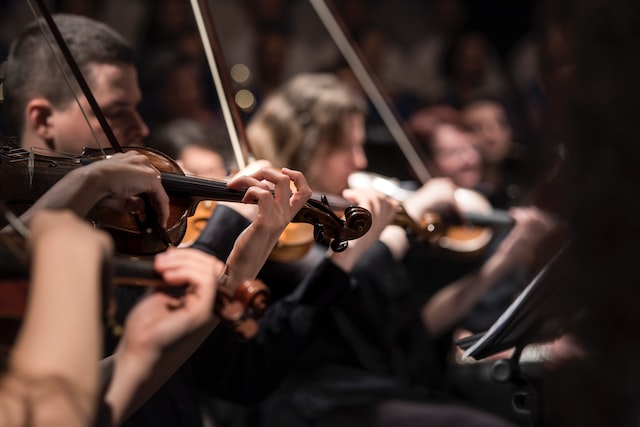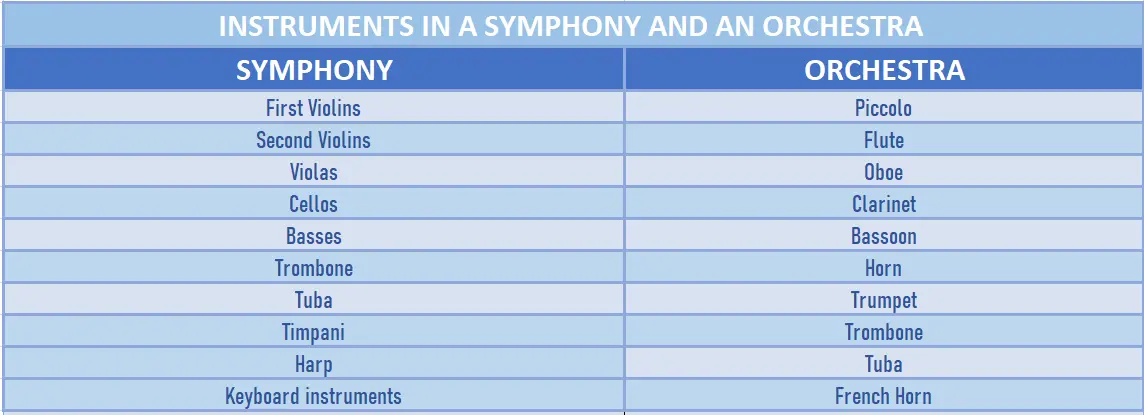The difference between an orchestra and a symphony is subtle but significant. Orchestras are generally larger groups of musicians that come together to perform classical music while symphonies focus specifically on large-scale works written for orchestra by major composers. The word “symphony” is often used interchangeably with “orchestra,” but there is a subtle difference. A symphony is a specific type of musical composition, usually for orchestra, that has four distinct movements or sections. The word “symphony” can also refer to the Orchestra itself playing this type of composition.
What is an orchestra?
(Photo by Larisa Birta on Unsplash )

An orchestra is a group of musicians who play together on various instruments, typically including stringed instruments, brass instruments, woodwinds, and percussion. The term orchestra can refer to the physical place where the musicians play (e.g., the “orchestra pit” in a theater) or the group of musicians themselves.
What is a symphony?
(Photo by Arindam Mahanta on Unsplash )

A symphony is a large-scale musical composition for orchestra, typically in four movements. The first movement is usually in sonata form and the second and third movements are in contrasting forms. The fourth movement is often in rondo form. A typical symphony orchestra has four sections: strings, woodwinds, brass, and percussion.
The difference between orchestra and symphony
An orchestra is a large group of musicians who play together on various instruments, whereas a symphony is a piece of classical music that is written for an orchestra to perform. The main difference between the two is that an orchestra is a live group of musicians, while a symphony is a composition.
Orchestras typically have between 40 and 100 members and are divided into sections, such as strings, woodwinds, brass, and percussion. A full symphony orchestra will have all four of these sections. The conductor leads the orchestra in rehearsals and performances.
Symphonies are usually longer than other pieces of orchestral music and are divided into four parts or movements. They often tell a story or convey a mood, and can be quite complex. Beethoven’s Symphony No. 9, for example, has four movements and lasts around 70 minutes.
What are the types of orchestras?
There are four primary types of orchestras: Symphony orchestras, Chamber orchestras, Pit orchestras, and String orchestras.
Symphony orchestras are the largest and most well-known type of orchestra. They typically have between 80 and 100 musicians and play classical music. The instruments in a symphony orchestra include woodwinds, brass, percussion, and strings.
Chamber orchestras are smaller than symphony orchestras and usually have between 30 and 50 musicians. They often play more intimate pieces of music than symphony orchestras. The instruments in a chamber orchestra can vary, but they typically include woodwinds, strings, brass, and percussion.
Pit orchestras are typically found in theaters and accompany plays, musicals, ballets, and operas. They usually have between 20 and 30 musicians and the instruments used can vary depending on the production they are accompanying. However, pit orchestras typically include woodwinds, brass, strings, percussion, and keyboards.
String orchestras are made up entirely of string instruments (i.e., violins, violas, cellos, double basses). They can be any size from a small group of 10 musicians to a large Symphony Orchestra with 100 or more players. String Orchestras typically play classical music but can also play other genres such as pop or jazz.
What are the types of symphonies?
There are four types of symphonies: The Italian, German, French, and Russian.
The Italian symphony emerged in the early 18th century. It is characterized by its simple melodies and clear harmonies.
The German symphony developed in the late 18th century. It is marked by its use of contrapuntal techniques and complex harmonic structures.
The French symphony originated in the early 19th century. It is characterized by its elegant melodies and rich harmonies.
The Russian symphony emerged in the late 19th century. It is known for its dramatic sound and powerful emotions.
What is a symphony orchestra?
A symphony orchestra is a large orchestra that typically contains between 80 and 100 musicians. The instruments in a symphony orchestra are divided into four sections: string, woodwind, brass, and percussion.
The string section is typically the largest section and includes the following instruments: violin, viola, cello, and double bass. The woodwind section includes the following instruments: flute, oboe, clarinet, and bassoon. The brass section includes the following instruments: trumpet, trombone, and French horn. The percussion section includes the following instruments: timpani, snare drum, bass drum, cymbals, and xylophone.
Symphony orchestras are used to perform classical music repertoire such as symphonies, concertos, and operas. They are also used to perform film scores and popular music arrangements.
What is the difference between symphony orchestra and philharmonic?
The main difference between a symphony orchestra and a philharmonic orchestra is that a symphony orchestra typically contains more players than a philharmonic. A typical symphony orchestra will have around 80-100 players, while a philharmonic will have 50-70. Additionally, symphony orchestras tend to play a wider range of music than philharmonics. While both types of orchestras primarily play classical music, symphonies will also often play contemporary pieces, whereas philharmonics are more likely to stick to traditional repertoire.
What is the largest orchestra in the world?
An orchestra is typically made up of between 60 and 100 musicians, while a symphony typically has around 80 members. The largest orchestras in the world have over 200 members. The Berlin Philharmonic Orchestra is the largest orchestra in the world, with over 250 members.
What are the instruments in an orchestra?
An orchestra typically contains the following instruments: strings (violin, viola, cello, bass), woodwinds (flute, oboe, clarinet, bassoon), brass (trumpet, trombone, tuba), and percussion (timpani, snare drum, cymbals). A symphony orchestra is simply a larger orchestra that usually contains at least 100 musicians.
What are the instruments in an symphony and orchestra ?

What is the hardest orchestra piece?
It is difficult to definitively say what the hardest orchestra piece is, as difficulty can be subjective and depends on various factors such as the skill level of the performers, the complexity of the score, and the technical demands of the piece. Some pieces that are often considered challenging for orchestras include “The Rite of Spring” by Igor Stravinsky, “Symphonie Fantastique” by Hector Berlioz, and “Pictures at an Exhibition” by Modest Mussorgsky (as orchestrated by Maurice Ravel). These pieces require precision, technical skill, and interpretation from the performers, making them challenging to master.
Which is the most famous orchestra?
There are many famous orchestras around the world, but the most famous and prestigious one is arguably the Vienna Philharmonic Orchestra. This orchestra was founded in 1842 in Vienna, Austria, and is known for its distinctive sound and high level of musical artistry. It is composed of over 100 musicians who are selected through a rigorous audition process, and its repertoire includes classical and contemporary music from a variety of composers.
The Vienna Philharmonic Orchestra is known for its annual performance of the New Year’s Concert, which is broadcast to over 90 countries and has become a cultural event watched by millions around the world. The orchestra has also collaborated with many famous conductors and soloists, including Leonard Bernstein, Herbert von Karajan, and Gustavo Dudamel.
Apart from the Vienna Philharmonic Orchestra, other famous orchestras include the Berlin Philharmonic, the London Symphony Orchestra, the New York Philharmonic, the Chicago Symphony Orchestra, and the Boston Symphony Orchestra. These orchestras have also established their own unique sounds and reputations for excellence, and have contributed significantly to the world of classical music.
Featured Image By – Photo by Samuel Sianipar on Unsplash








